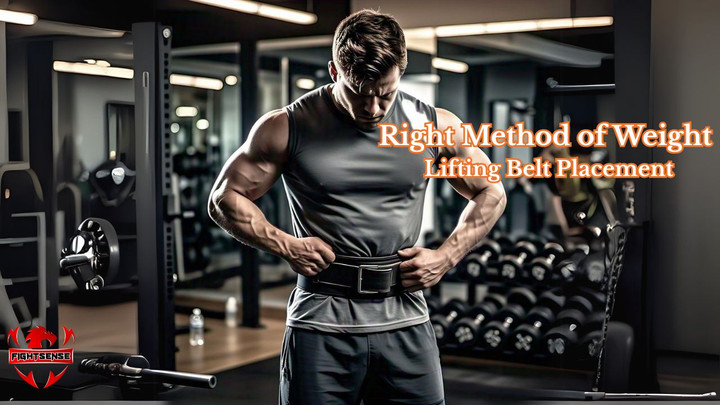Right Method of Weight Lifting Belt Placement
23rd Mar 2025
A must-have tool for strength training, a weight lifting belt placement is meant to improve core stability, guard the lower back, and increase lifting performance. When worn correctly, it helps to generate intra-abdominal pressure, therefore supporting heavy lifts.
Still, inappropriate weight lifting Instead of a benefit, belt placement might create discomfort, reduced efficiency, and maybe damage. Especially in key lifts like deadlifts and squats, we will discuss the proper posture of your belt to increase support, optimise power output, and enhance safety in this entire instructional.
Key Highlights
- Put the weight lifting belt some above the hip bones for best support.
- Change the weight lifting belt placement depending on the lift—lower for deadlifts, higher for squats.
- Avoid either too tight or too loose weightlifting belts.
- Warm-ups should test multiple weight lifting belt positions to find the best fit.
- Brace strongly, then raise with deep belly breaths.
Weight Lifting Belt Placement: Why It Matters?
Perfect weight lifting belt placement will help to maximise lifting effectiveness, minimise injury risk, and give best spinal support. When worn appropriately, a lifting belt greatly increases the pressure inside the abdomen, which makes the core more stable and increases overall power production. This extra support helps keep your spine safe and your form correct while you move quickly.
If you want to get the most out of your deadlifts, big squats, or overhead presses, you need to know how and where to put your belt. Putting your belt in the right location lets you lift more weight, lowers your risk of injury, and lets you do better with each rep.
Weight Belt Placement: Finding the Right Spot
Proper weightlifting belt placement plays a crucial role in maximising performance and preventing injuries. Depending on your body structure and the type of lift, the belt should sit snugly around your lower abdomen, directly over the hip bones. This positioning provides optimal support to your core while ensuring stability during heavy lifts.
It’s essential to wear the belt tight enough to allow effective bracing but not so tight that it restricts breathing or movement. By understanding the correct weight lifting belt placement, you can enhance your lifting technique and maintain safety during intense workouts.
Lifting Belt Placement for Different Lifts
Depending on the workout, lifting belt placement could require little adjustments:
- Squats: Position the belt somewhat higher on the torso to aid with lower back issues.
- Deadlifts: Position the belt lower, close to the navel, to prevent too considerable spinal flexion.
- Overhead Press: The ideal position in overhead press is mid-torso.
Typical Mistakes in Weightlifting Belt Placement
Poor weightlifting belt placement can result in reduced efficacy and discomfort. Avoid some often-committed mistakes:
- Wearing the belt too high undermines the support of the lower back.
- Fastening it too tightly can restrict breathing.
- Positioning it too low could cause unnecessary stomach pressure.
Belt Position: How Tight Should Your Belt Be?
Correct belt posture combines tension and flexibility. A good lifting belt should be tight enough to put a lot of pressure on your stomach and keep your core stable as you lift big things. This support helps keep your spine safe and makes all of your lifting better, especially when you do compound actions like squats and deadlifts.
The belt also needs to be flexible enough to let you take deep breaths in your abdomen. To keep your tension and strength, you need to be able to breathe and brace properly during each lift. Your belt should help you do this, not get in the way. Sliding two fingers between your torso and the belt will help you to find the proper fit if they fit firmly.
Deadlift Belt Placement: Strength Maximising Approach
Proper deadlift Deadlifts' performance will be much influenced by belt position. The belt should sit lower than in squats and match the abdominal bracing if one wants a neutral spine.
Methods of Perfect Deadlift Belt Placing:
- Arrange the belt somewhat above the hip bones.
- Keep it tight but not overly so.
- Breathe deeply to engage your core; then, lift.
Deadlift Belt Position: Correcting for Performance
Setting your deadlift belt to the right place can make a big difference in how much power you can produce and how well you perform overall. Putting things in the right spot helps keep your core stable without getting in the way of your natural movement, which is important for lifting big things with the most force.
Make sure the belt isn't too high, which might hurt your ribs, or too low, which can make it hard for your hips to move. The easiest way to determine the right fit for your belt is to try it out during warm-up sets to see which one gives you the most support and freedom of movement.
Shop Now !
Finally
To have the best performance, stability, and safety while lifting weights, you need to learn how to put on your weightlifting belt correctly. It's important to modify the belt to fit your physique and the way you work out, whether you're doing deadlifts, squats, or overhead presses. A good Fightsense weightlifting belt gives you the support and flexibility you need to get the most out of every lift and make sure your placement is just right.
Disclaimer: The contents of this article are intended only for educational purposes. See a competent trainer always before changing your lifting regimen.

